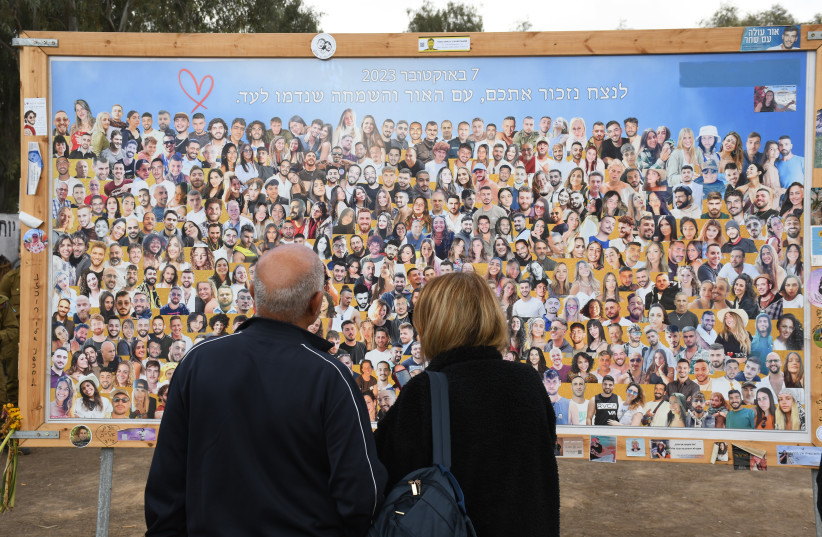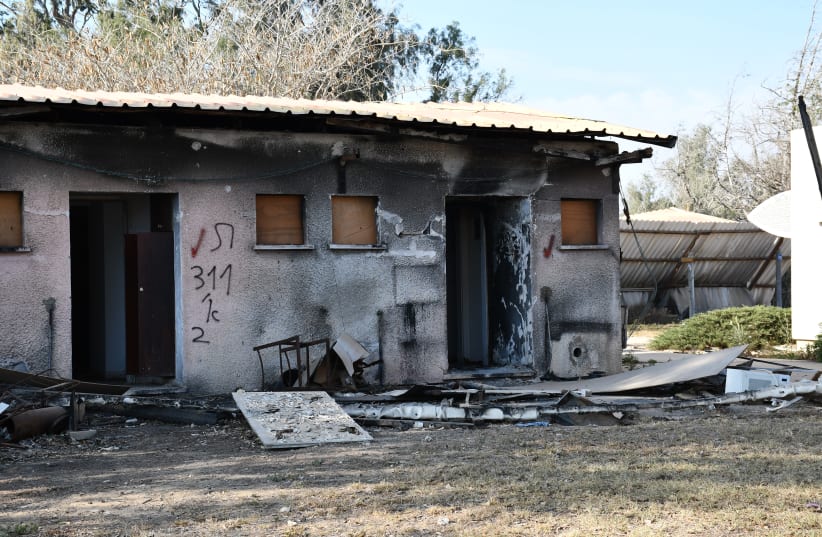Lines of freshly planted trees. Israeli flags, each at a different height on a stick above where a tree will one day grow, fly in the wind. It’s been six months since the Nova festival massacre took place here.
On each flag is printed the name of one of the victims who was killed here, or in the nearby forests and fields, during the massacre. Meanwhile, the sound of artillery can be heard in the distance. By this late point in the day, the military had already announced that it was rotating forces out of Gaza.
A sense of change, noted by the passage of half a year, can be felt here. Time continues to pass, and each day ends, but there is no closure for the families, who are left in limbo while Hamas continues to hold 134 hostages.
On Sunday morning, families of the Nova victims gathered at the site. They talked of the feeling of abandonment they experienced, especially from the government; they talked of pain, of getting treatment for that pain. They spoke about how this massacre could have been prevented, and how difficult it is to return to life.
Right then was when the news broke that a mourner’s wreath was sent to the family of 19-year-old hostage Liri Albag, blaming the government for the lack of a deal. The Shin Bet (Israel Security Agency) later said it suspected Iranian forces were behind it. It was as if the news hammered home just how deeply wrong it is that this is still the situation six months later.


How can it be that six months into the war the hostages are held just across the border from where I am standing?
Gaza is not very large, so wherever you stand along the border, you are always a few miles from the coast and not far from Rafah. There are 134 people across the border; IDF units are being withdrawn. Israeli citizens were promised that “there won’t be any more Hamas” when the war was over, and that military pressure would lead to the release of the hostages. From the border, it is obvious that neither has come to pass.
For me, Sunday was a return to a border I’ve been to many times since October 7, as well as before the war as well. Back in 2005, before the Disengagement from Gaza, I visited Netzer Hazani, a settlement in Gaza near Khan Yunis.
Border region became a target for Hamas
Afterward, this border region became a target for Hamas; rockets rained down on Sderot. This a place where there were many wars: in 2009, 2012, 2014, and briefly in 2021; it always carried dangers. At Kibbutz Nirim, a resident told of threats dating back to the 1970s. There was always a threat from Gaza, but there were also times of peace and efforts at coexistence.
The sense on Sunday, at Nova, is that all that is broken. The festival grounds today are made up of various memorials, like the new section of trees that will grow and an area of photos of the victims, staked in the ground so that each victim has their area.
Besides the few monuments, such as some benches and individual make-shift memorials people have left, or graffiti on a concrete bunker, much remains as it would have been before the festival. There are trees with no undergrowth; there is a dirt road running down Route 232, which runs parallel to the border. It was on this dirt road, from the festival grounds to the main road, where cars would have been stacked up on October 7 after the festival organizers stopped the music and told everyone to run and hide.
I look around among the trees and think about the thousands of people fleeing; their desperation and confusion. The area is familiar to me from the many videos that came out that morning; the bathrooms where people hid, the bar where people were massacred, the fields that people tried to drive through and flee through, the rescuers – like the Davidians – who came and saved people.
Six months later, this conjures up the ghosts of the past, the spirits that roam this forest now. Nearby Kibbutz Mefalsim had almost 1,000 residents on October 7. Like Kfar Aza, it was a place people wanted to live. The residents in many of these communities say that these kibbutzim were 95% heaven and 5% hell – before October 7.
Today, many of them are empty and lack residents – proud, peace-loving people who were evacuated. At Mefalsim, there is a sign supporting the “Kaplan” protesters, the anti-Netanyahu camp. These kibbutzim are proud of their heritage. In a small building housing the archive of Mefalsim, there is a photo of the bolt-action rifles acquired by the Jewish state via Czechoslovakia in 1948 that helped defend Israel.
On October 7, the members of the security team, using modern rifles, defended this community successfully from the terrorists. In many cases, the terrorists assigned groups of 30-40 men to attack each border community. When they didn’t succeed in some places, there was no second wave. When they did succeed, such as breaking into Kfar Aza, waves of men came from Gaza to loot and murder.
In Sderot, terrorists shot upon entry, firing bullets at the streets, targeting the police station in a battle that went on for hours into the night. The building eventually burned down. Residents had to hide indoors for several days amidst fear that infiltrators were still inside. Eventually, the city of 30,000 was evacuated. Six months later, it recovered a lot: many residents returned, and there were even traffic jams downtown. But the signs of war remain – soldiers stand at the city entrances, checking cars.
In Ofakim, around 30 minutes away from Gaza by car, one particular neighborhood saw an intense gunfight; more than two dozen people were killed in different incidents. In total, around 50 residents of the city were killed, some in a bus for retirees that was traveling to the Dead Sea from Ofakim through Sderot. The bus was attacked, and the people were killed. Police officers in Ofakim were killed as well. In one neighborhood, the terrorists attacked several homes. Residents helped defend the city and eventually, the terrorists were hunted down.
Back on the border with Nirim, the small, 240-person community, it is quiet, but eerily so, like a ghost town. The kibbutz minimarket has been reopened, and the customers are mostly soldiers who come over from units stationed nearby. Several green parrots inhabit a tree, apparently escaped pets. Other former pets are wandering around, including a cat that wouldn’t stop following me. Wild dogs had infiltrated from Gaza on October 7, following the marauding looters.
In contrast to Sderot and Nova, fields of memories, Nirim is almost deserted, the burned homes on one side of the kibbutz unchanged since October 7, cleared on October 10 and 11 of bodies.
In the background, like a whisper, ring concerns about what comes next in Gaza, with the IDF decision to pull out Battalion 98, though the military remains steadfast in its goals, holding as a stark symbol of a lack of strategy, a symbol that haunts these roads.
I drive back along the 232, the same road the terrorists would have driven on; it is quiet today. Six months ago, this was a road of death. No matter how much the fields are full of green today, and the orchards of oranges are pregnant with fruit, this place will always hold the massacre it witnessed.
